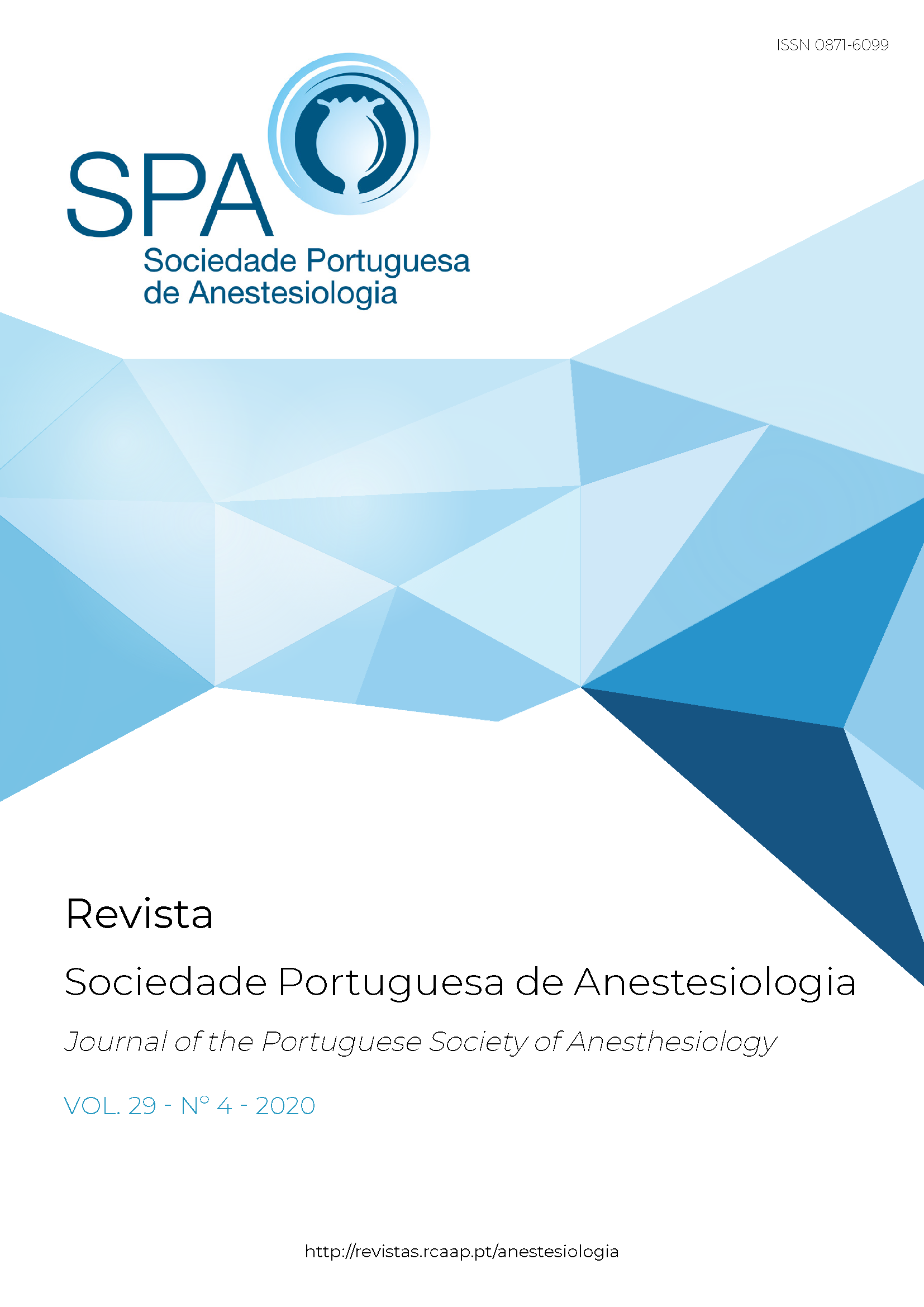Importância do NIRS na monitorização da isquemia da medula espinal durante a reparação endovascular da aorta torácica
DOI:
https://doi.org/10.25751/rspa.19577Keywords:
Thoracic aortic aneurysm, endovascular procedures, spinal cord ischemia; near-infrared spectroscopyAbstract
Endovascular aortic procedures are becoming increasingly common, replacing open surgical repair in the majority of patients with thoracoabominal aortic aneurysms. In these procedures, spinal cord perfusion is vulnerable. A high risk patient for spinal ischaemia was presented for a branched 22 cm long thoracic endovascular aortic repair (TEVAR) elective procedure. We used a monitoring approach with a subarachnoid catheter, according to our institutional protocol for TEVAR procedures, complemented with the use of Near-infrared spectroscopy (NIRS). Continuous non-invasive surveillance of peri-spinal oxygen supply-demand balance during the procedure (NIRS), together with mean arterial pressure and cerebrospinal fluid pressure trends, was of uttermost importance to help us distinguish the pathophysiology mechanism behind the ischemic insult and act accordingly. NIRS has the potential to satisfy all the criteria for ideal spinal cord monitoring, such as noninvasive, continuous and real-time information about spinal cord perfusion and oxygenation.
Downloads
References
[2] LeMaire SA, Ochoa LN, Conklin LD, Widman RA, Clubb FJ, Ündar A, et al. Transcutaneous near-infrared spectroscopy for detection of regional spinal ischemia during intercostal artery ligation: Preliminary experimental results. J Thorac Cardiovasc Surg. 2006;132:1150-5.
[3] Boezeman RPE, van Dongen EP, Morshuis WJ, Sonker U, Boezeman EHJF, Waanders FGJ, et al. Spinal Near-Infrared Spectroscopy Measurements During and After Thoracoabdominal Aortic Aneurysm Repair: A Pilot Study. The Annals of Thoracic Surgery. 2015;99:1267-74.
[4] Etz CD, Kari FA, Mueller CS, Silovitz D, Brenner RM, Lin H-M, et al. The collateral network concept: A reassessment of the anatomy of spinal cord perfusion. J Thorac Cardiovasc Surg. 2011;141:1020-8.
[5] Scheeren TWL, Bendjelid K. Journal of clinical monitoring and computing 2014 end of year summary: near infrared spectroscopy (NIRS). Journal of Clinical Monitoring and Computing. 2015;29:217-20.
[6] Moerman A, Van Herzeele I, Vanpeteghem C, Vermassen F, François K, Wouters P. Near-Infrared Spectroscopy for Monitoring Spinal Cord Ischemia During Hybrid Thoracoabdominal Aortic Aneurysm Repair. Journal of Endovascular Therapy. 2011;18:91-5.
[7] Badner NH, Nicolaou G, Clarke CFM, Forbes TL. Use of Spinal Near-Infrared Spectroscopy for Monitoring Spinal Cord Perfusion During Endovascular Thoracic Aortic Repairs. Journal of Cardiothoracic and Vascular Anesthesia. 2011;25:316-9.
[8] Demir A, Erdemli Ö, Ünal U, Taşoğlu İ. Near-Infrared Spectroscopy Monitoring of the Spinal Cord During Type B Aortic Dissection Surgery. Journal of Cardiac Surgery. 2013;28:291-4.
[9] Etz CD, von Aspern K, Gudehus S, Luehr M, Girrbach FF, Ender J, et al. Near-infrared Spectroscopy Monitoring of the Collateral Network Prior to, During, and After Thoracoabdominal Aortic Repair: A Pilot Study. European Journal of Vascular and Endovascular Surgery. 2013;46:651-6.
[10] Luehr M, Mohr F-W, Etz CD. Indirect Neuromonitoring of the Spinal Cord by Near-Infrared Spectroscopy of the Paraspinous Thoracic and Lumbar Muscles in Aortic Surgery. Thorac cardiovasc Surg. 2016;64:333-5.
[11] Minto Charles F, MB, ChB, Schnider Thomas W, MD, Shafer Steven L, MD. Pharmacokinetics and Pharmacodynamics of Remifentanil: II. Model Application. Anesthesiology: The Journal of the American Society of Anesthesiologists. 1997;86:24-33.
[12] Schnider Thomas W, Dr med, Minto Charles F, MB, ChB, Gambus Pedro L, MD, Andresen C, MD, Goodale David B, DDS, PhD, Shafer Steven L, MD, et al. The Influence of Method of Administration and Covariates on the Pharmacokinetics of Propofol in Adult Volunteers Anesthesiology: The Journal of the American Society of Anesthesiologists. 1998;88:1170-82.
[13] Nicolaou G, Ismail M, Cheng D. Thoracic Endovascular Aortic Repair: Update on Indications and Guidelines. Anesthesiology Clinics. 2013;31:451-78.
[14] Takeda Y, Sakata Y, Ohtani T, Tamaki S, Omori Y, Tsukamoto Y, et al. Endovascular Aortic Repair Increases Vascular Stiffness and Alters Cardiac Structure and Function. Circulation Journal. 2014;78:322-8.
[15] Dias-Neto M, Reis PV, Rolim D, Ramos JF, Teixeira JF, Sampaio S. Strategies to prevent TEVAR-related spinal cord ischemia. Vascular. 2017;25:307-15.
Downloads
Published
How to Cite
Issue
Section
License
Articles are freely available to be read, downloaded and shared from the time of publication.
The RSPA reserves the right to commercialize the article as an integral part of the journal (in the preparation of reprints, for example). The author should accompany the submission letter with a declaration of copyright transfer for commercial purposes.
Articles are published under the terms of the Creative Commons Attribution Non-Commercial License (CC BY-NC).
After publication in RSPA, authors are allowed to make their articles available in repositories of their home institutions, as long as they always mention where they were published.


